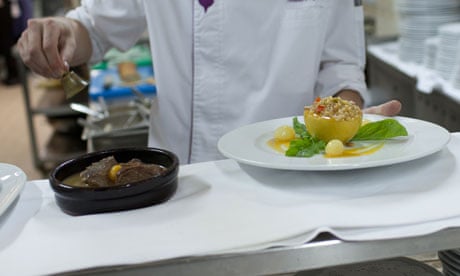It's an amateur chef's nightmare: a list of ingredients without instructions on how much to use or how to prepare them.
But for Batur Durmay, owner of what's believed to be the only restaurant in the world that serves Ottoman imperial cuisine, the challenge was inviting.
"Ever since my early childhood, food was the only topic around the family's dinner table. We never talked about politics, sports, music, movies – but we loved to explore anything connected with food," said Durmay. His restaurant, Asitane in Istanbul, takes its cue from the sumptuous feasts of the 16th century. Diners have included royalty and cabinet ministers.
It started with two books: the first ever kitchen ledger of the imperial palace in Topkapi dating from 1469 that listed about 45 dishes served at the Ottoman court, and a book describing the royal festivities of 1539 celebrating the circumcision of Suleiman the Magnificent's sons Cihangir and Beyazit. "That text gave us the names of 100 different dishes served at the circumcision feast, but we still didn't have any recipes, or any ingredients," Durmay says.
The team scoured archives underneath Topkapi Palace and at the national library, looking for documents, books and scrolls that would hint at how the sultan's cooks had managed to tickle imperial palates. A task for culinary detectives: with Istanbul as the final destination of both the silk and the spice routes – where any wares were taxed before being shipped further west – official harbour documents gave approximate details of spices, produce and foodstuffs available in the Ottoman capital.
Registers with the amount, origin and date of purchase of every food item that entered the imperial kitchens helped to narrow the search. And finally, finding the right measures and the right way to prepare a dish was a matter of trial and error.
Asitane has recreated 400 different recipes. Combined with elements of contemporary fine dining, imperial dishes ranging from the 15th to the 19th century are served.
Most diners are foreign tourists. "Many Turks are very conservative when it comes to food," Durmay said. And the Turks' relationship with their Ottoman past is problematic. "In school we are taught that the Ottoman sultans were cowards and traitors who sold our country to the British." The era is perceived as backwards and decadent.
"It is hard to find Turkish experts of the Ottoman language who help us decipher Ottoman texts. I now work with scholars from a university in Berlin," says Durmay.
But lately the Ottoman era has regained popularity in popular culture. Asitane provides catering for the set of Muhteşem Yüzyil (Magnificent Century), a glossy and successful TV show that depicts the life of Suleiman the Magnificent and caused outrage among conservatives in Turkey for showing the sultan enjoying alcohol and the company of women.
"Many restaurants calling themselves Ottoman actually only serve traditional Turkish food," Durmay said. "But Ottoman cuisine fuses the tastes of the Middle East, the Balkans, the Caucasus and central Anatolia. It goes far beyond the kebab."
